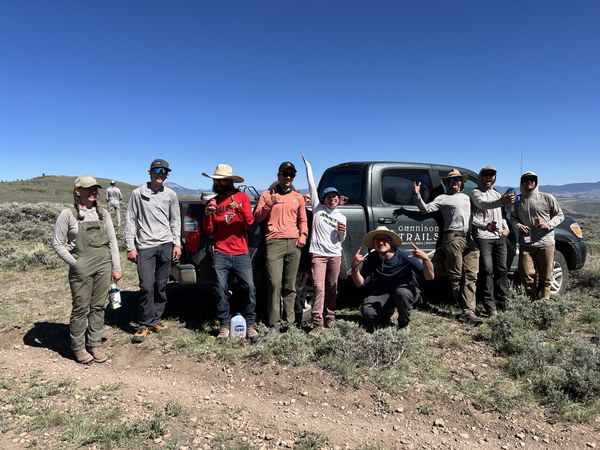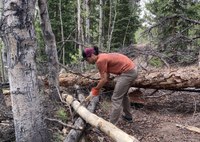Last month’s announcement of a seasonal worker hiring freeze by the U.S. Forest Service (USFS) has sent ripples through the outdoor recreation community, particularly in Colorado. This decision, driven by budget constraints, will significantly impact the agency's ability to maintain and improve our beloved trails, campgrounds, and wilderness areas. By managing these lands, the USFS and partner organizations help ensure that they remain accessible and enjoyable for those who venture out to explore them. With a hiring freeze in place, essential tasks like trail maintenance, campground upkeep, and forest health initiatives may be delayed or even canceled. As a result, popular outdoor destinations may experience reduced services, delayed maintenance, and potential overcrowding. Colorado Mountain Club (CMC) hopes to help alleviate some of the strain.
“On the front end, it gives us a little bit of anxiety about resources from the Forest Service and what that's going to look like,” explains Brian Bergeler, Conservation Director at Colorado Mountain Club. “The Forest Service has already been stretched pretty thin with respect to personnel resources over the last few years, so this hiring freeze might continue to strap their resources a little bit and spread them even more thin than they have been.”
Seasonal CMC stewardship crew members are hired each year to complete work in different wilderness areas around Colorado. How much work they’re able to complete is based on several factors, including available programs and how many crew members they’re able to hire, which are both reliant on funding from outside sources. “This year’s impact will mainly come down to support and the bandwidth of the Forest Service and whether they will be able to kind of administer any programs or projects that we're affiliated with,” says Bergeler. “Right now, we’re looking at the bigger picture and trying to estimate what the impact of the freeze and lack of funding is going to have on our public lands.”
In 2024 alone, the CMC stewardship team spent thousands of hours inventorying more than 500 wilderness campsite areas, maintaining trails, disposing of litter left behind by trail users, clearing trails of downed trees, adding in stream crossings, maintaining and repairing signage, and repairing and constructing drainage structures to reduce the erosion and flooding in areas where people recreate.

But there are also limitations for CMC’s stewardship crew. “The bulk of our funding comes from grants and federal funding and things we have to apply for. Nothing is guaranteed year to year. Sometimes the funding amounts drop significantly, or funding opportunities disappear completely, so at the beginning of the fiscal year, we have to go out and find that money again,” explains Bergeler. “We also have a lot of additional expenses that sometimes aren't covered by the grant funding. Right now we have three vehicles in the conservation department, and unfortunately one of them was damaged this year and is currently in the shop. It’s an expensive repair that needs to be done if we want to be able to use the vehicle again to get crews back out there, but that cost doesn’t come out of our funding agreements. With overhead costs and keeping things going, donations definitely help with our efforts.”
Bergeler hopes that CMC members and the general public will also take more of an interest in using the Recreation Information Management System (RIMS) app to let the USFS know where efforts are most needed. RIMS allows users to report issues, suggest improvements, and provide feedback on outdoor experiences. By actively using RIMS, users can help direct the attention of land managers to critical areas in need of repair.
“Our app lets people who are already out on the trail help with wilderness monitoring efforts,” says Bergeler. “Being out there and collecting this data, whether it's a downed tree or damaged bridges or illegal camping, is incredibly valuable. Being able to hand that over to the Forest Service essentially lets us act as their eyes and ears so that they can focus the limited resources they have on areas that need immediate attention instead of just guessing.”
RIMS is available in app stores, and is free for users. You can watch a brief video on how to use the app, but additional funding would help expand the app and make it even easier to use.
Your Support Can Make a Difference
Donations to the CMC help fund vital work. By contributing, you empower us to:
- Hire skilled stewardship crews: We can recruit and train dedicated individuals to tackle challenging projects that bigger agencies won’t be able to address this year.
- Purchase essential tools and equipment: We can invest in high-quality tools that improve efficiency and safety for the members of our team.
- Expand our reach: We can take on more projects and impact a wider range of public lands.
- Enhance RIMS: We can continue to improve RIMS, making it easier for you to report issues and provide feedback.
Together, we can ensure that Colorado's outdoor recreation opportunities thrive, even in the face of adversity. Join us in supporting these conservation efforts and making a positive impact on our public lands.
 Felicia Brower
Felicia Brower

Add a comment
Log in to add comments.